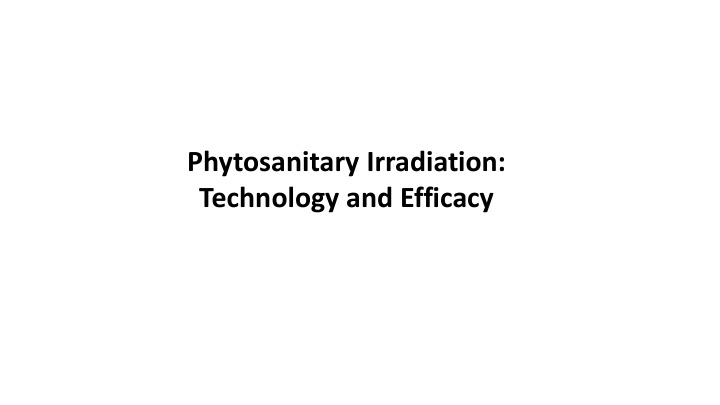



Phytosanitary Irradiation: Technology and Efficacy
Outline • Irradiation Technology • Insect Efficacy • Phytosanitary Irradiation History
Background Global trade of commodities New products for US consumers • • New export markets for US producers • Exotic pests
Definitions & Concepts Phytosanitary Treatment- Regulatory measure intended to prevent the introduction or spread of quarantine pests by killing or sterilizing pests with high efficacy Examples of Treatments: Irradiation Heat (44-48 ° C) Cold (0-2 ° C) Fumigation
Definitions & Concepts Irradiation - The exposure of a substance to ionizing energy (radiation) for the purpose of achieving some desired technical benefit • Food and agricultural products phytosanitary treatment, shelf life extension, • sprout inhibition, pathogen reduction • Sterilization of medical products • Materials modification • semiconducters, gemstone coloration, polymers
Irradiation (gamma, e-beam, X-ray) at typical energies for radiation processing WILL NOT cause any of the irradiated products to become radioactive or leave any radioactive residue.
Definitions & Concepts Dose vs Absorbed Dose- Dose refers to the amount of ionizing radiation delivered; Absorbed dose refers to the quantity of radiating energy (in Gray ) absorbed per unit of mass of a specified target Gray (Gy)- a unit of absorbed dose where 1 Gy is equivalent to the absorption of 1 joule per kilogram of the specified material (1 Gy = 1 J/kg)
Typical Absorbed Dose Requirements Purpose Dose (Gray) Inhibit Sprouting 50 Phytosanitary Irradiation 60-400 Pathogen Reduction (Meat and Poultry) 1,500 Spice Sanitation 6,500 Medical Device Sterilization 25,000 Food Sterilization (NASA) 46,000
Approved Irradiation Sources Gamma : Cobalt 60 or Cesium 137 emits photons during decay E-beam : High energy electrons propelled (particle beam) from an electron gun X-ray : High energy electrons are converted to X-rays (photons)
Components of Irradiation Facilities • Radiation source (gamma, x-ray, e-beam) • Biological shield • Product transport system • Control and safety equipment X-Ray Facility Image Credit: IAEA
Gamma Irradiator (Cobalt 60) Cherenkov radiation
E-beam Irradiator Image Credit: IAEA
X-Ray Irradiator
Definitions & Concepts Dose Distribution- The spatial variation of absorbed dose throughout the process load, the dose having the extreme values D max and D min. Note: FDA limits fresh fruit and vegetable treatments to 1000 Gy From www.teasystems.com/WhitePapers/WeirPW_DoseUniformity.htm
Insect Efficacy The objective of using irradiation as a phytosanitary measure is to prevent the introduction and spread of plant pests This can be realized by achieving certain responses in the target pest(s) such as: • mortality • preventing development • sterility • inactivation Mortality is usually not the target response for phytosanitary irradiation treatments and live insects may remain after treatment
Insect Efficacy Effects of ionizing radiation on insect pests: • Free radicals cause tissue damage Broken chemical bonds • • DNA damage can be fatal or prevent reproduction .
Absorbed Doses Required for Sterility vs. Mortality 4500 4000 4000 Absorbed Dose (Gray) 3500 3000 2500 Sterility 2000 Mortality 1307 1500 1000 300 500 92 0 Brevipalpus chilensis Plum Curculio From Castro et al., 2004 and Hallman, 2003.
Phytosanitary Irradiation History • 1986. US FDA approves irradiation of fruits and vegetables for insect disinfestation • 1989. Approval of Hawaii papaya • 1995. Hawaii produce exported with special permit • 1996. USDA APHIS approves phytosanitary irradiation against fruit flies on any commodity
Phytosanitary Irradiation History 2002. Irradiation approved for all admissible fruits and vegetables from all countries to US 2004. Australian mangos to New Zealand 2006. USDA APHIS approves generic doses 2007. Thai mango to United States 2011. First Upon Arrival Irradiation Treatment 2015. First US exports of irradiated fruit
Generic vs. Specific Treatment Generic Specific • Treatment covers • Treatment applies to a multiple pests and single pest commodities • Often commodity- • Subset of insects from specific group are tested • Single pest tested
APHIS Approved Irradiation Treatments, as of March 2017 Pest Dose (Gy) All fruit flies of the family Tephritidae 150 All insects except adults and pupae of the order Lepidoptera 400 Eggs and larvae of the family Tortricidae 290 Pest Dose (Gy) Rhagoletis pomonella 60 Anastrepha ludens, Anastrepha obliqua, Anastrepha suspensa 70 Conotrachelus nenuphar 92 Anastrepha serpentina, Bactrocera jarvisi, Bactrocera tryoni, Ceratitis capitata, Copitarsia declora 100 Aspidiotus destructor, Cylas formicarius, Euscepes postfasciatus, Omphisa anastomosalis, 150 Pseudaulacaspis pentagona, Bactrocera cucurbitae, Bactrocera dorsalis Sternochetus frigidus 165 Cydia pomonella, Grapholita molesta, Epiphyas postvittana 200 Cryptophlebia ombrodelta, Cryptophlebia illepida 250 Brevipalpus chilensis, Sternochetus mangiferae 300
Generic Treatments in Use Trading Partners Commodity Dose Mexico to US Citrus, manzano 150 Gy pepper, mango India & Pakistan to US Mango 400 Gy Mexico to US Guava 400 Gy Vietnam to US Dragonfruit 400 Gy Australia to New Zealand Mango, papaya 250 Gy Australia to New Zealand Lychee 350 Gy Hallman, G., 2012. Generic phytosanitary irradiation treatments. Radiation Physics and Chemistry. 81:861–866.
Concluding Thoughts Benefits of PI • Effective for many types of pests • Minimal impact on commodity quality • May be applied at diverse points post-harvest
Recommend
More recommend